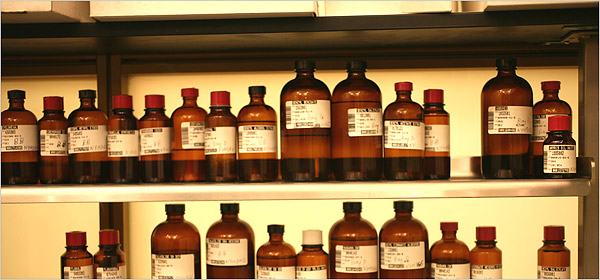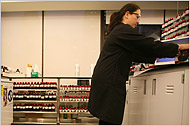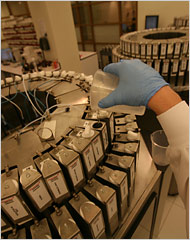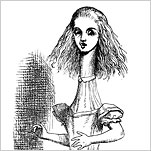Its scent is reminiscent of a mixture of a just-picked apple and a rose in its prime. But to the Takasago International Corporation, which manufactures this synthetic material, it smells even sweeter.
Last year, that chemical, with the trade name Thesaron, became an essential ingredient in a new perfume, Silver Shadow Altitude, released by Davidoff, a brand owned by Coty. Playing a role in one of the most successful international fragrance trade names — Davidoff has had a scent on the top five perfume best-seller list for the last 20 years — means that molecule is highly profitable for Takasago.
Thesaron is a perfume industry version of pharmaceuticals like Lipitor, the commercial name of the active ingredient developed by Pfizer that lowers blood cholesterol. Drug companies have long made a lot of money by patenting new molecules.
Similarly, the scent makers — Symrise of Holzminden, Germany; Givaudan of Geneva; International Flavors and Fragrances of New York; and Takasago of Tokyo — spend billions on research to find new smell molecules, patent them and sell them. The innovative scents of these “captives,” as the patented molecules are known, are crucial to enticing consumers to buy the 600 or so new perfumes introduced every year and appealing to buyers of other fragrant products like soaps and air fresheners.
Captives have other virtues as well. Jean Jacques, Takasago perfumer, put Thesaron in Altitude, for example, because it solved three problems: Thesaron has the fruity/rosy note of a very expensive class of molecules called rose ketones, but it costs far less and can be used in unlimited amounts (rose ketones are restricted because they set off allergic reactions at high doses).
Ned Polan, a vice president for fragrance ingredient research at I.F.F., pointed out another quality of captives: they allow perfumers to recreate smells found in nature and create new, wholly unknown ones.
“There are no new colors to see and very few new sounds, but we are actually creating new, unique smells no one has ever smelled before,” Mr. Polan said. It is, quite literally, as if a paint company could make a new shade of blue.
Givaudan produces natural and synthetic perfumery raw materials and employs the perfumers who use these materials to make fragrances. In 2006 Givaudan’s sales were 2.9 billion Swiss francs ($2.64 billion), and the double-digit sales growth of its fine-fragrances division — which that year made perfumes for Yves Saint Laurent, Burberry, Tom Ford and Hugo Boss — was powered by Givaudan’s captives.
Givaudan began creating molecules in 1902. “Our new molecule platform drives our innovation and takes up a most significant part of our R&D budget,” said Kate Greene, vice president for marketing at Givaudan. “We have over 50 researchers dedicated to new captives.”
Like Pfizer, Abbott Laboratories or Novartis, Givaudan’s annual report prominently lists its new patents: “Three new molecules were introduced to the perfumers’ palette in the first half of 2007. Zinarine, natural green and tomato leaf notes with aspects of mint, fig, hyacinth; petitgrain Paradisamide, a long-lasting, fresh tropical fruit note with nuances of grapefruit, rhubarb and cassis; and Florymoss, a floral, green, mossy note which blends well with floral fruity and spicy accords.”
As with other scent makers, Givaudan does not break out the share of its research devoted to creating captives, but the company’s total research budget in 2007 was 371 million Swiss francs. According to Ms. Greene, Givaudan has become the leading producer of captives; its perfumers put the captive Amber Ketal in Aqua di Gio from Armani and Polo Blue from Ralph Lauren.
Each year, Givaudan’s scientists develop over 2,000 new molecules. After scent evaluation, synthesis studies and toxicity testing, “only three or four per year are selected for launch,” Ms. Greene said.
But they are crucial. Captives “provide newness to our perfumers’ palettes,” she said, “which in turn brings innovation to our clients’ brands.”
Takasago has just reorganized its two main chemical research centers in Japan and the United States. A scientist there, Ryoji Noyori, shared the Nobel Prize in chemistry in 2001 for his work in the synthesis of new captives.
Takasago’s captive Hindanol is in the scent it makes for Johnson & Johnson’s self-tanning product Holiday Skin. It smells of sandalwood, but it can do what no natural sandalwood can.
Where the natural is heavy and used as a perfume’s “base note” — smelled only after the lighter molecules have diffused — Hindanol is highly diffusive and thus can be used as a “top note,” allowing the user to smell sandalwood where she would not have before.
“Captives give us performance and functional attributes in different applications like soap or detergents where you might need specific attributes,” said Michael Popplewell, vice president for corporate research at I.F.F.
One example is a molecule that stays firmly on fabric, perfect for scenting laundry detergents. “That’s a specific attribute we like to see,” he said.
Captives also bolster ecological efforts. A captive synthetic jasmine can smell stronger than its natural counterpart, so perfumers can use fewer chemicals to get the same power, which reduces both the company’s costs and the amount of water needed to wash it away.
John C. Leffingwell, a scent industry analyst, notes: “Sandalwood is becoming outrageously expensive, around $1,700 per kilogram, and in short supply.” India’s sandalwood forests have been so decimated, further harvesting has been banned. Also, captives do not require costly and polluting fertilizers or cause farmers to deplete the soil.
The bulk of I.F.F.’s fundamental research spending goes to new molecules, and I.F.F. supports a large interdisciplinary scientific team.
“Your chemist generates a molecule,” Mr. Popplewell said. “Then you have to analyze what you’ve created — is it pure, how does it work? — then you have to create a synthesis, and then you have to figure out how to scale up to industrial production levels.”
Each molecule is assessed for potential commercial value — and each must pass toxicology tests. Those selected for the patent process are written up by I.F.F.’s patent lawyers and submitted to patent offices around the world. Responses arrive, Mr. Polan said, “generally in six months to several years.”
In the United States, patents generally run 17 years, but after about 10 years, scent makers will start selling captives to their competitors, sacrificing exclusivity but generating another revenue stream.
Mr. Popplewell will not divulge how many researchers at I.F.F. work on new captives. “But we’re increasing activities in open innovation,” he said. “There’s lots of smart people out there, so we’re collaborating with neighboring disciplines, universities, consultants and outside institutes.”
Scent makers do not reveal the cost for each molecule. “The cost depends on what the patent office makes us do, on the chemical, on the testing we have to do to get technical details right on yield, purity and reproducibility of the process synthesis chemistry, on whether we need new equipment and processes to make the molecule,” Mr. Popplewell said. “Also the planned use or production volume: how much do we think we’re going to use in perfumes.”
He added: “It isn’t cheap.”
But in the end, it leads to I.F.F. captives like a proprietary musk I.F.F. uses in Sarah Jessica Parker’s perfume Lovely.
Costs can limit the number of new molecules that the scent makers bring to market. “The biggest,” said Jonathan Warr of Takasago’s research department, is “safety testing, particularly now with more restrictions being imposed by clients. We’re only interested in captives with global scope, materials that can be manufactured and marketed in China and Japan as well as Europe and North America.”
One recent successful Takasago captive is l-muscone. A musk, l-muscone has been known for years, but no one could come up with a way to make it economically until Takasago did. It then patented not the molecule but the synthesis pathways to produce it.
L-muscone is still expensive (“It’s a luxury material,” Mr. Warr said, “costing high four figures per pound”), and it has no trade name yet because Takasago does not sell it to anyone else. It’s a “nature identical” — identical to the molecule found naturally in a gland in the musk deer — but Takasago produces only the synthetic version.
Andrea Lupo, a perfumer at Takasago, put l-muscone in the perfume Intimately Night for David and Victoria Beckham and Coty, their licensee.
“It helps create the scent’s unique signature,” she said. “The Coty people wanted a fragrance of edginess and masculinity. I wanted to give it a fresh, edgy top, and I used ginger and mandarin to blast that out, with a warm, sensual sandalwood, amber and coconut middle,” including the noncaptive synthetic aldehyde C-18.
With conventional musks, Ms. Lupo said, the perfumer has to use a lot, but that then damps the other materials.
“The benefit of l-muscone is that you can get a musk effect using a small amount,” she said. “So I was able to get a dark sexiness without repressing my sparkling top notes. It lets you use musk in a different way.”
















